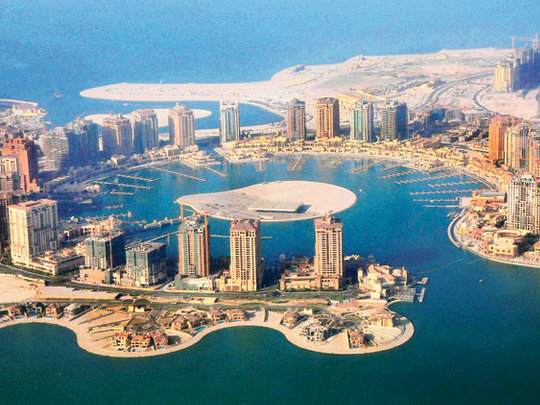
London: Many real estate developments in the Gulf may have been killed off by the financial crisis, but Qatar is pressing ahead with its grandiose property projects.
Despite delays, the $20 billion (Dh73.43 billion) Pearl development on reclaimed islands beyond the West Bay area of Doha is continuing, and the first ring of towers will soon be completed.
Officials say Qatar is also progressing with plans to build the 21-square-kilometre Lusail City to the north of the Qatari capital. However, official optimism and continuing projects cannot mask the fact the Qatari property market has been hurt by the fallout from the financial crisis.
Investor sentiment has been dented by the regional real estate downturn, and access to mortgages has been severely constricted. Though less affected than some of its neighbours, thanks to heavy government spending and a continued influx of people, rents and prices have dropped markedly.
The overall level of price declines in Doha is hard to gauge because of a lack of sales volumes, but rents at top-tier office towers in the New District have fallen by about 25 per cent since the peak in 2008, and occupancy rates have fallen from 95 per cent to about 85 per cent, says CB Richard Ellis, property consultants.
Falling prices
Residential compound rents have dipped about 10 per cent, and apartments at completed towers at the Pearl have fallen by more than a third to about 12,000 riyals (Dh12,057) per square metre, the consultancy says.
"Residential apartments in master-planned off-plan projects, such as the Pearl, have come under some pressure as confidence in completions is on the wane, as is investor and speculator bullishness," says Mike Williams, a senior director at CB Richard Ellis.
Yet there is a sense of optimism in Doha that the market will recover, as expatriates continue to arrive in the country. Euro-monitor, an industry analytical company, forecasts that the population of Qatar will swell to 2.4 million by 2030.
The most important catalyst will be a pick-up in bank lending, experts say. Qatari banks remain reluctant to lend, but are in far better shape than most of their regional peers, and private sector credit growth is forecast to recover tentatively soon.
"There is some belief that mortgage finance will become more widely available in the short term and this will lead a recovery over the coming years," says Williams.
Sales volumes also appear to be improving — albeit slowly. Coreo Real Estate, a Doha property agency that was founded in late 2008, only saw one sale every other month last year, but now sells one or two properties every month.
"We started in a recession but Doha is probably the best place in the world to do so. People are still waiting to see where prices will go, but they seem to have stagnated recently so I think buyers will return soon," says Khalifa Al Misnad, chief executive of Coreo.
JPMorgan estimated the country is spending nearly $50 billion on the Pearl, Lusail City, the new Doha financial district, Barwa Al Khor, a coastal city north of the capital, and Dohaland, a regeneration of the city's old parts.
However, progress on some of these is likely to be sluggish. Lusail, for example, is a development by Qatari Diar, the real estate arm of the country's sovereign wealth fund, and will only be built by developers once demand is healthier, a senior banker predicts.
Prices stable
With sale prices remaining more or less unchanged in the second quarter, it could be that Qatar's freehold property market may now have bottomed out. If this trend continues for another quarter and more, the market will certainly see it as a big relief.
The average re-sale prices at The Pearl-Qatar, which is the focal point of freehold sales in the Gulf state, range from 10,000 (Dh10,081) to 13,000 riyals compared with the second half of 2008 when prices peaked between 18,000 and 20,000 riyals.
"The secondary market is most active with enquiries coming from investors and owner-occupiers searching for ready-to-occupy apartments at prices below current replacement cost," said a report by Asteco.
Seven residential high-rises have been handed over at The Pearl-Qatar and three more should come through in the present quarter. "Competition is driving the market towards maturity, this, coupled with the continuing development on the island, is increasing confidence levels," the report added.
"Expatriates are drawn to buy and live on The Pearl-Qatar instead of paying rent to a landlord."
Potential buyers — and tenants — will have a lot to choose from going forward. On the rental side, the new stock has had a role in tamping own rates by between 15 to 20 per cent in some of localities, particularly The West Bay as well as on The Pearl-Qatar.
However, there are the other locations such as Al Saad, Bin Mahmoud and Old Airport where rentals have actually stablised compared with the first quarter.
"Overall, the downturn in the rental market has provided prospective tenants with more choice of accommodation while landlords are having to lower their rents and in some cases offer incentives such as rent-free periods," the report said.











